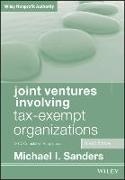Condividi
Fr. 193.00
Michael I Sanders, Michael I. Sanders
Joint Ventures Involving Tax-Exempt Organizations - 2017 Cumulative Supplement
Inglese · Tascabile
Spedizione di solito entro 1 a 3 settimane (non disponibile a breve termine)
Descrizione
The definitive guide to compliance for nonprofit joint ventures
Joint Ventures Involving Tax-Exempt Organizations explores the laws, rules, and policies surrounding increasing collaborations between the nonprofit and for-profit sectors. Comprehensive, authoritative, and focused on the practical, this resource has been fully updated to reflect the latest rulings and regulatory changes pertaining to tax-exempt organizations. Countless footnotes, numerous citations to case law, Internal Revenue Code sections, and other relevant authority are provided, along with a host of useful sample forms.
In an era of challenging economic forces, budgetary constraints and potential tax legislation, nonprofits and for-profits are partnering in creative arrangements to achieve mutual financial and tax-exempt goals. Improper structuring and inadequate safeguards can jeopardize an organization's tax-exempt status; careful planning is critical. Thorough examination of relevant laws and rulings guides practitioners and participants so that both the non-profit and for-profit partners will understand the requirements for maintaining tax-exemption:
Analyze the various joint venture configurations that will protect tax-exempt status, including the new partnership audit rules
Propose solutions to common challenges such as debt restructuring, use of tax credit financing, and asset protection issues
Identify the structures best suited to achieve various goals based on applicable legal factors
Partnering with for-profit businesses has brought both successes and unforeseen challenges to universities, research institutions, hospitals, low-income housing developments, and many more. As the charitable funding environment continues to face stresses, alternative avenues to generate revenue, such as joint ventures, will only become more prevalent. Joint Ventures Involving Tax-Exempt Organizations provides an invaluable resource for lawyers and nonprofits alike, putting the critical information you need at your fingertips.
Sommario
Preface xi
Acknowledgments xiv
Chapter 1: Introduction: Joint Ventures Involving Exempt Organizations 1
1.4 University Joint Ventures 1
1.5 Low-Income Housing and New Markets Tax Credit Joint Ventures (Revised) 1
1.6 Conservation Joint Ventures 2
1.10 Ancillary Joint Ventures: Rev. Rul. 2004-51 2
1.14 The Exempt Organization as a Lender or Ground Lessor 2
1.15 Partnership Taxation (Revised) 3
1.17 Use of a Subsidiary as a Participant in a Joint Venture 3
1.22 Limitation on Private Foundation's Activities That Limit Excess Business Holdings (New) 3
1.24 Other Developments 4
Chapter 2: Taxation of Charitable Organizations 5
2.1 Introduction 5
2.2 Categories of Exempt Organizations 5
2.3
501(c)(3) Organizations: Statutory Requirements (Revised) 5
2.6 Application for Exemption (Revised) 6
2.7 Governance (Revised) 12
2.8 Form 990: Reporting and Disclosure Requirements 13
2.10 The IRS Audit (New) 14
2.11 Charitable Contributions (Revised) 17
Chapter 3: Taxation of Partnerships and Joint Ventures 25
3.3 Classification as a Partnership 25
3.4 Alternatives to Partnerships 25
3.8 Tax Basis in Partnership Interest 26
3.9 Partnership Operations 26
3.11 Sale or Other Disposition of Assets or Interests (Revised) 27
3.12 Other Tax Issues (Revised) 27
Chapter 4: Overview: Joint Ventures Involving Exempt Organizations 31
4.2 Exempt Organization as General Partner: A Historical Perspective 31
4.6 Revenue Ruling 2004-51 and Ancillary Joint Ventures (New) 32
4.9 Conversions from Exempt to For-Profit and from For-Profit to Exempt Entities (New) 32
4.10 Analysis of a Virtual Joint Venture 33
Chapter 5: Private Benefit, Private Inurement, and Excess Benefit Transactions 35
5.1 What Are Private Inurement and Private Benefit? (Revised) 35
5.2 Transactions in Which Private Benefit or Inurement May Occur 36
5.3 Profit-Making Activities as Indicia of Nonexempt Purpose 37
5.4 Intermediate Sanctions (Revised) 37
5.7 State Activity with Respect to Insider Transactions 38
Chapter 6: Engaging in a Joint Venture: The Choices 41
6.2 LLCs 41
6.3 Use of a For-Profit Subsidiary as Participant in a Joint Venture (Revised) 41
6.5 Private Foundations and Program-Related Investments (Revised) 45
6.6 Nonprofits and Bonds 50
6.7 Exploring Alternative Structures 52
6.8 Other Approaches (Revised) 52
Chapter 7: Exempt Organizations as Accommodating Parties in Tax Shelter Transactions 55
7.2 Prevention of Abusive Tax Shelters (Revised) 55
7.3 Excise Taxes and Penalties 56
Chapter 8: The Unrelated Business Income Tax 57
8.1 Introduction 57
8.3 General Rule (Revised) 58
Chapter 9: Debt-Financed Income 59
9.1 Introduction 59
9.2 Debt-Financed Property 59
9.6 The Final Regulations (New) 59
Chapter 10: Limitation on Excess Business Holdings 63
10.1 Introduction 63
10.2 Excess Business Holdings: General Rules (Revised) 63
10.3 Tax Imposed 63
10.4 Exclusions (Revised) 63
Chapter 12: Healthcare Entities in Joint Ventures 67
12.2 Classifications of Joint Ventures 67
12.3 Tax Analysis 67
12.4 Other Healthcare Industry Issues 68
12.5 Preserving the 50/50 Joint Venture 68
12.9 Government Scrutiny 69
12.11 The Patient Protection and Affordable Care Act of 2010:
501(r) and Other Statutory Changes Impacting Nonprofit Hospitals 69
12.12 The Patient Protection and Affordable Care Act of 2010: ACOs and Co-Ops: New Joint Venture Healthcare Entities 72
Chapter 13: Low-Income Housing, New Markets, Rehabilitation, and Other Tax Credit Programs 75
13.3 Low-Income Housing Tax Credit 75
13.4 Historic Investment Tax Credit 76
13.6 New Markets Tax Credits (Revised) 80
13.10 The Energy Tax Credits (Revised) 94
Chapter 14: Joint Ventures with Universities 97
14.5 Faculty Participation in Research Joint Ventures 97
14.6 Nonresearch Joint Venture Arrangements 97
14.7 Modes of
Riassunto
The definitive guide to compliance for nonprofit joint ventures Joint Ventures Involving Tax-Exempt Organizations explores the laws, rules, and policies surrounding increasing collaborations between the nonprofit and for-profit sectors.
Dettagli sul prodotto
| Autori | Michael I Sanders, Michael I. Sanders |
| Editore | Wiley, John and Sons Ltd |
| Lingue | Inglese |
| Formato | Tascabile |
| Pubblicazione | 30.11.2017 |
| EAN | 9781119410188 |
| ISBN | 978-1-119-41018-8 |
| Pagine | 160 |
| Categoria |
Scienze sociali, diritto, economia
> Economia
> Economia aziendale
|
Recensioni dei clienti
Per questo articolo non c'è ancora nessuna recensione. Scrivi la prima recensione e aiuta gli altri utenti a scegliere.
Scrivi una recensione
Top o flop? Scrivi la tua recensione.

